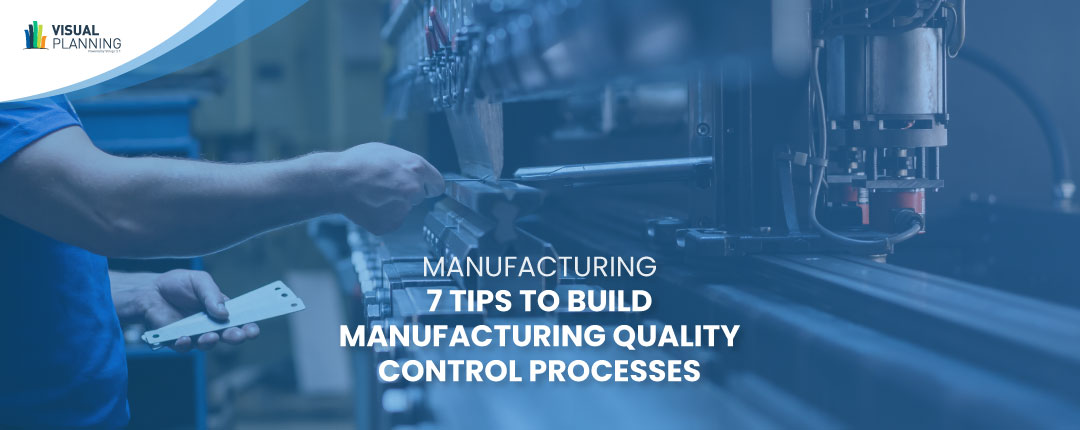Quality control in manufacturing is essential for building customer loyalty, increasing sales and managing the bottom line. Discover how you can leverage tools like scheduling software in manufacturing to enhance quality without impacting production volumes and other important metrics.
The Importance of Quality Control Management

Strong quality control management can lead to many benefits in a manufacturing environment. The most obvious is that the outputs of your processes, including products, are more likely to meet or exceed customer satisfaction when production processes are well-controlled and quality is considered at each point. But other benefits also demonstrate the importance of quality control, including:
- Increased safety for employees and customers. Quality products are safer products; they have fewer or no defects that might lead to customer injury or illness. But quality management doesn’t just keep your customers safe. Managing quality in a manufacturing space also means looking at the safety of workers as well as ensuring everyone follows the right processes and has access to tools and resources to keep them safe.
- Better employee engagement. Employees that see leadership taking a vested interest in quality — of the outputs, the work environment, the processes, and the safety of staff — tend to be more engaged. Most people want to provide work that has value, and when your employees can be proud of the products they produce, they can take ownership of their work in a way that supports better engagement.
- Increased customer loyalty. When customers can rely on your brand or business to provide high-quality products consistently, they will be loyal — buying from you even if it means a slight cost increase or inconvenience over buying from the competition. The majority of people are willing to wait a little longer, pay a little more, or go a little further to buy products they can trust.
- Reduced waste. Managing quality throughout your processes reduces waste by cutting down on errors that must be thrown out or reworked.
- Better cost optimization. Implementing quality control methods ensures better cost optimization across your entire enterprise. Within the production line, you save money by avoiding waste and rework, engaging employees who may then work more efficiently or productively, and reducing downtime due to safety events or errors that might halt production. Outside of the product line, higher quality optimizes costs by retaining customers and increasing returns over the life of each customer.
7 Tips to Develop Your Quality Control Process in Manufacturing

To get the benefits of quality control in manufacturing, you must build a process to oversee quality. While there are plenty of quality control methodologies, it’s important to understand the specific needs of your business and how you can support them with quality assurance and control. Follow the steps below to define and build quality control processes that work well in your organization.
1. Set Standards for Manufacturing Quality

Obviously, you want to set high-quality standards. But what, exactly, does that mean for your organization? Consider conducting a quality control standards audit to:
- Discover external requirements, if any. Find out what external stakeholders, including customers, vendors, or business partners, expect and whether there are contracts and service level agreements defining those requirements. Your quality control standards must at least meet these requirements. For example, if you have an SLA that says you will supply 1,000 widgets a week with an error rate less than 1%, your quality standards can’t allow more than that.
- Decide on internal requirements. You can, however, aim for quality that exceeds external requirements. Consider business needs, costs and what might be a challenging but possible goal for your manufacturing teams. You may also want to consider building room in your manufacturing quality standards for failure that doesn’t impact customers. If the client requires an error rate less than 1%, for example, internally you might aim for an error rate less than 0.5%.
- Ensure your standards are measurable. Quality control works best when you can measure the results of your efforts. Otherwise, whether or not you succeed is subjective and you won’t be able to analyze the impact of changes to your processes and quality management.
2. Optimize Processes With Scheduling Software

It can be easy to get bogged down in making things perfect when you concentrate on quality control management. But you must also ensure your teams and processes are producing at the right scale. One of the best ways to balance the business needs to manage quality and increase production is with quality control software.
The right scheduling software can help you manage quality by ensuring that the right resources and people are on the job when you need them. Here’s an example of how using good scheduling software in manufacturing can help you keep quality high:
Imagine a manufacturing company that produces high-quality toys. Normally, the production line has no problem keeping up with demand while also adhering to the quality the brand is known for. But what happens if one of the toys goes viral? Or the holiday season increases demand for some of the toys? Trying to produce many more toys with the same resources can lead to quality issues as people move too quickly, try to take on too many tasks or become overworked and burned out.
Intelligent scheduling software, such as Visual Planning’s software, can help manufacturing managers address many of these issues. Some ways good scheduling software helps you maintain quality in production include:
- Ensuring more viable overtime schedules. You can set rules in your scheduling software to ensure people aren’t scheduled for more than a certain number of hours a week or don’t work back-to-back doubles. By supporting work-life balance and rest for your workforce, you can increase productivity and cut down on error rates.
- Aligning resources with tasks. In environments where certain people are trained to do certain work (such as machine shops), scheduling software takes the puzzle out of planning your production line. You can enter data that tags tasks and equipment as requiring certain skill sets. You can also tag employees with those skill sets, and the scheduling software automatically aligns people with the jobs they’re trained or certified to do.
- Planning ahead for major changes in production schedules. With the right production scheduling software, you can input previous product data or forecasts to understand how your staff and process needs may change over time. Looking ahead to those needs gives you time to scale up or down, creating a resource management plan and hiring new workers or bringing in temps to meet increased demands before that growth leads to quality issues.
3. Utilize Manufacturing Quality Metrics to Grow and Improve Your Operations

Once you’ve defined your quality control process, including standards you can use to identify success, continue to gather metrics on quality. Consistently looking at your quality metrics helps you understand whether your quality control processes are working. They also help you identify continued areas for improvement.
For example, at the start of your quality control management program, you may have found that one production line had a 5% error rate. During analysis of the process, you may have found that 50% of those errors came from one task in the process. Once you correct that issue, you may have dropped your error rate to 2.5% — it’s a big improvement, but there’s room for more. You might look at quality metrics from other parts of that process, identify the next most-impactful issue and work to correct that.
Continuous process improvement initiatives — such as Six Sigma — note that perfection isn’t achievable. However, manufacturing organizations can use quality metrics to drive continuous process improvement initiatives to move ever closer to perfect.
4. Keep Your Shop Floor Clean and Organized

Process quality is critical to increasing the quality of products and other outputs, but the way your team manages its workspace is also important. Quality control in manufacturing isn’t complete without quality control inspections that consider the organization and cleanliness of the shop floor.
Inspections should:
- Look for overall cleanliness. A clean shop floor keeps workers safer by ensuring spills are cleaned up right away and other items that might cause trips and falls are put away. A clean working environment allows people to take pride in what they do, and that transfers to the quality of the work.
- Checking for proper use of tools and equipment. Quality inspections should ensure people are using resources correctly and that employees are well-trained on the equipment they use.
- Ensure specific safety rules are followed. Quality audits might note whether employees were wearing the proper safety gear, for example, or that machines and tools were being used in the safest way.
5. Stay Organized With Resource Management Software

One of the most useful resource scheduling software features is the ability to set routine tasks and assign them to employees. This can be especially valuable in keeping shop floors clean. It’s easy for production teams and others to get caught up in ensuring production quotas are met. Without a prompt to do so, teams may not break away from that momentum to handle routine cleaning.
But if you include cleaning requirements in your scheduling software, you can build in stop points where cleaning occurs. Or, in some cases, you may end up with resources completely dedicated to cleaning that are scheduled across the manufacturing environment at various times.
6. Ensure Proper Quality Control Training and Resources

The best outcomes from quality programs come when you have the right resources. That includes using quality control software for manufacturing and ensuring everyone who uses that software (and other resources) is appropriately trained. Visual Planning helps you achieve those goals with ongoing support and consulting, ensuring you and your employees are trained to use our software to improve quality and scheduling in your organization.
7. Utilize Technology To Enhance Quality Control

Utilizing resource management and scheduling software to control quality in your organization enhances all the benefits you get from basic quality control. When you back quality management with the right technology, you:
- Save a lot of time. Could you accomplish everything discussed above with manual scheduling processes? Possibly, but it would take a lot of time, and you may have to return to the drawing board multiple times a day as resources and priorities shift. Scheduling software lets you automatically align resources with business needs, even when those shifts occur. What might take someone an entire day to accomplish manually can take mere minutes with the right scheduling software.
- Potentially reduce costs further. Automated scheduling, fail-safes that ensure the right resources for each task, and other features in the right scheduling software help you cut costs without reducing quality.
- Simplify complex processes. The right technology simplifies complex scheduling processes so you can meet production needs without getting bogged down in the details. Whether you run a single shift or three shifts a day with rotating needs, scheduling software can simplify getting people and resources in position.
How Visual Planning Can Help Enhance Quality Control Management

Visual Planning has features that support everyone from ops managers to shift leaders on the shop floor. We’ve leveraged our expertise in manufacturing to create a tool that lets you schedule machines, people, and other resources, see those schedules in real-time and make on-the-fly changes to keep up with demand while supporting quality.
Find out more about how our solution can help with quality control in manufacturing. Schedule a demo today.
Manale is passionate about digital marketing. She joined STILOG I.S.T in 2018.
She brings SEO & SEA expertise, email marketing and creative content marketing to create a great brand experience for Visual Planning customers.



